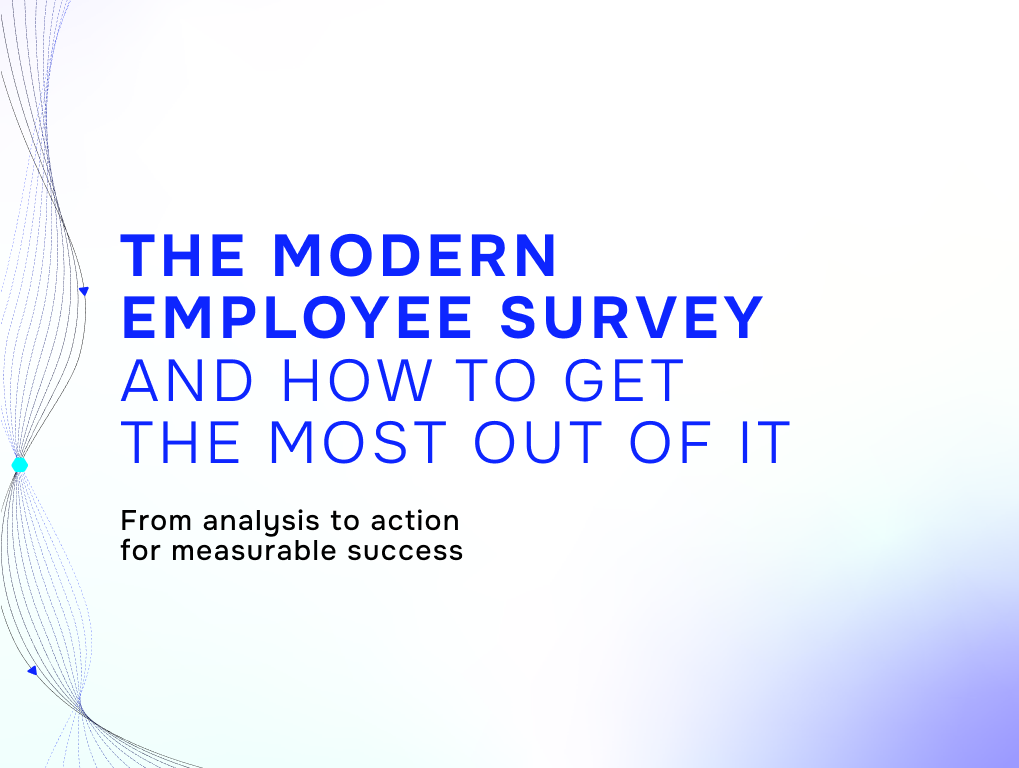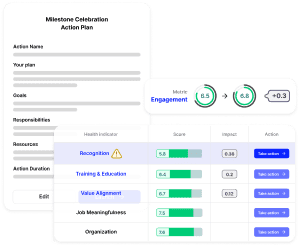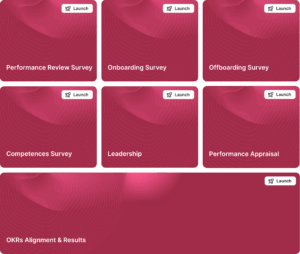How to Strengthen Employee Engagement to Build a More Loyal Workforce
Imagine the impact on your organization if half of your team were to leave.
While this may sound like an extreme scenario, data from Gallup shows that 51% of global employees are either watching for or actively exploring new job opportunities, putting them at high risk for turnover.
Retention has always been one of the biggest challenges for HR teams, and this challenge has become even more difficult to navigate in recent years with the rise of remote work, greater access to global job markets, and shifting employee expectations around work-life balance and flexibility.
So, how can you ensure your top talent stays engaged and committed to your organization?
As an HR leader, one of the most impactful areas you can focus on is employee engagement.
Employee engagement is when employees are fully engaged and present at work—emotionally, physically, and cognitively.
Research shows that actively engaged employees are far more likely to stay than their disengaged peers. Not only that, higher engagement boosts productivity by 17% and company profitability by 21%. By focusing on employee engagement, you don’t just hold onto your talent — you can drive your entire organization toward greater success.
At atwork, our internal data shows a high statistical relationship between employee engagement and organizational commitment, as well as the intention to stay.
Here, we’re exploring top strategies for increasing employee engagement and retention within your workforce.
Recognize employee contributions
Recognition and rewards are crucial drivers of employee engagement. Research from Deloitte shows that employee engagement, productivity, and performance are 14% higher in organizations with recognition programs compared to those without. When employees feel their efforts are seen and valued, they are more likely to stay motivated, perform at their best, and remain loyal to the organization. A study by Quantum Workplace also found that employees who believe management will recognize their efforts are 2.7 times more likely to be highly engaged. On the flip side, feeling unseen and underappreciated can quickly lead to disengagement and, ultimately, turnover.
Here’s an example: Maria, a marketer, consistently goes above and beyond in her role—managing multiple campaigns, creating content, organizing cross-team initiatives, and working late to meet deadlines. Despite her dedication, Maria’s manager, overwhelmed with other responsibilities, rarely acknowledges her efforts and simply expects her to work independently without much feedback or recognition. Over time, Maria begins to feel that her extra efforts are invisible. Frustrated, she starts to question her value to the company and begins seeking out opportunities at companies where her contributions might be more appreciated.
This scenario is common, particularly in fast-paced work environments where the focus on team goals and revenue targets can overshadow individual contributions. As an HR leader, it’s important to make recognition a key part of your company culture and management practices.
Strategies for building a culture of appreciation
To start, consider implementing employee recognition programs, such as “Employee of the Month” or quarterly awards that celebrate both individual and team achievements. Additionally, conduct workshops for managers on providing more meaningful feedback and recognition to team members. Ensure that this recognition is personalized for each employee—some may prefer private, one-on-one feedback, while others may feel more valued when their achievements are celebrated publicly.
By embedding recognition into your company’s daily operations, you can create a culture of appreciation that boosts morale and strengthens retention.
Promote work-life balance
When it comes to employee engagement, work-life balance plays a critical role. Companies that actively promote work-life balance report significant benefits, including up to 85% higher productivity and 25% less turnover. However, organizations that don’t prioritize work-life balance often struggle with high burnout rates and a revolving door of employees, leading to decreased morale and productivity.
Here’s an example: Marcello, a store manager in the retail industry, has always taken pride in his work ethic. He frequently covers shifts for other team members and even comes in on his days off to handle unexpected issues. Unfortunately, relentless demands and unrealistic expectations from executives have taken a toll on his personal life. Marcello struggles to keep up with his family’s needs and feels constantly exhausted. He receives little support from his direct manager, who is too focused on sales targets to be concerned about employee well-being. Over time, Marcello realizes he’s burnt out and that the job isn’t worth all of his personal sacrifices.
This scenario is very common in industries like retail, hospitality, and healthcare, where high demands can quickly lead to increased stress and in some cases even burnout. These industries report some of the highest turnover rates, largely due to the intense pressures placed on employees with limited support. However, it is possible for HR leaders to create healthier, more sustainable work cultures where work-life balance is prioritized, leading to a more engaged and loyal workforce.
Strategies for enhancing work-life balance across your organization
One of the first steps is determining how to offer more flexible work schedules in a way that doesn’t disrupt business operations. If you’re in an industry where remote or hybrid work aren’t viable options, this can be particularly challenging. However, you can still explore options like staggered shifts, compressed workweeks, or allowing employees to swap shifts when personal issues come up. This kind of flexibility has been shown to significantly reduce employee stress, which in turn can increase engagement.
Additionally, implement a comprehensive time-off policy that includes sick days and paid vacation time, and actively encourage employees to use their time off. Ensure managers are modeling this behavior by taking time off themselves.
Finally, set realistic expectations for your team. Managers should be trained to continuously review and adjust workloads and check in with their team members to get a gauge of overall well-being. This can also be achieved through regular employee surveys.
Foster organizational commitment
Employee engagement is also linked with another crucial factor: organizational commitment.
According to internal data from atwork, physical and emotional engagement are strongly correlated to organizational commitment (by 0.493 and 0.438, respectively).
Organizational commitment is the emotional connection and loyalty an employee feels toward the company. When employees are committed, they aren’t just performing their tasks—they feel that their personal values are aligned with the company’s mission and are invested in the company’s growth. This plays a major role in determining how long employees stay with a company and how engaged they are.
Here’s an example: Kara, a software engineer, has been with her company for several years. She’s built strong relationships with her colleagues, feels aligned with the company’s values, and is passionate about the impact of the products she helps build. Even when she receives other job offers, she stays due to her belief in the company’s long-term vision. In contrast, her colleague Josh, views his role as a stepping stone to his next career move. Although Josh is competent, his lack of organizational commitment means he’s less likely to stay engaged and invest emotionally in his work.
Strategies for building organizational commitment
To strengthen organizational commitment, start by clearly communicating your company’s mission, values, and long-term goals. Employees are more likely to feel connected to an organization when they understand how their work contributes to something larger than themselves. Regularly reinforce this connection through all-hands meetings, internal communications, and employee feedback channels.
Another important strategy is to invest in employee development. When employees feel that the company is committed to their growth, they are more likely to reciprocate that commitment. Consider offering mentorship programs, career development workshops, or opportunities for internal mobility to help employees envision a long-term future with your organization.
Finally, prioritize a positive workplace culture that emphasizes collaboration, trust, and transparency. Employees who feel a sense of belonging and trust in leadership are more likely to develop strong organizational commitment.
Boosting engagement with atwork
Employee engagement and retention are common challenges for HR teams. While these strategies are excellent places to start, their impact will depend on your organization’s specific needs. That’s where atwork comes in.
atwork offers a science-based approach to conducting more effective employee surveys and measuring key metrics such as organizational commitment and intention to stay, helping you easily identify engagement and retention risks across your organization. Additionally, atwork’s AI-powered tools transform insights into personalized action plans, tailored to your organization’s needs.
Want to find out more? Request a demo of atwork today.
You may also like

Engaged to Care: Transforming Swiss Hospital Workforces through AI and Strategy
Swiss hospitals are facing rising burnout, absenteeism, and disengagement among staff — but AI-powered tools could be the key to turning things around. This study, conducted by students at Lucerne University of Applied Sciences and Arts in collaboration with atwork, explores how strategic HR technology can help transform employee engagement in the healthcare sector.

Optimizing Employee Engagement through Modern Surveys
Equip yourself with the knowledge and tools to drive organizational success and create a thriving workplace culture.

How do you get meaningful results from employee surveys?
We all know what it’s like: you get surveys in your e-mail inbox, requesting you to evaluate a service or your own employer. The questions and answers you can select are often the same. So, most people just sign off. A low response rate is not only irritating. If the rate is too low, the […]





 Guides
Guides  Studies
Studies